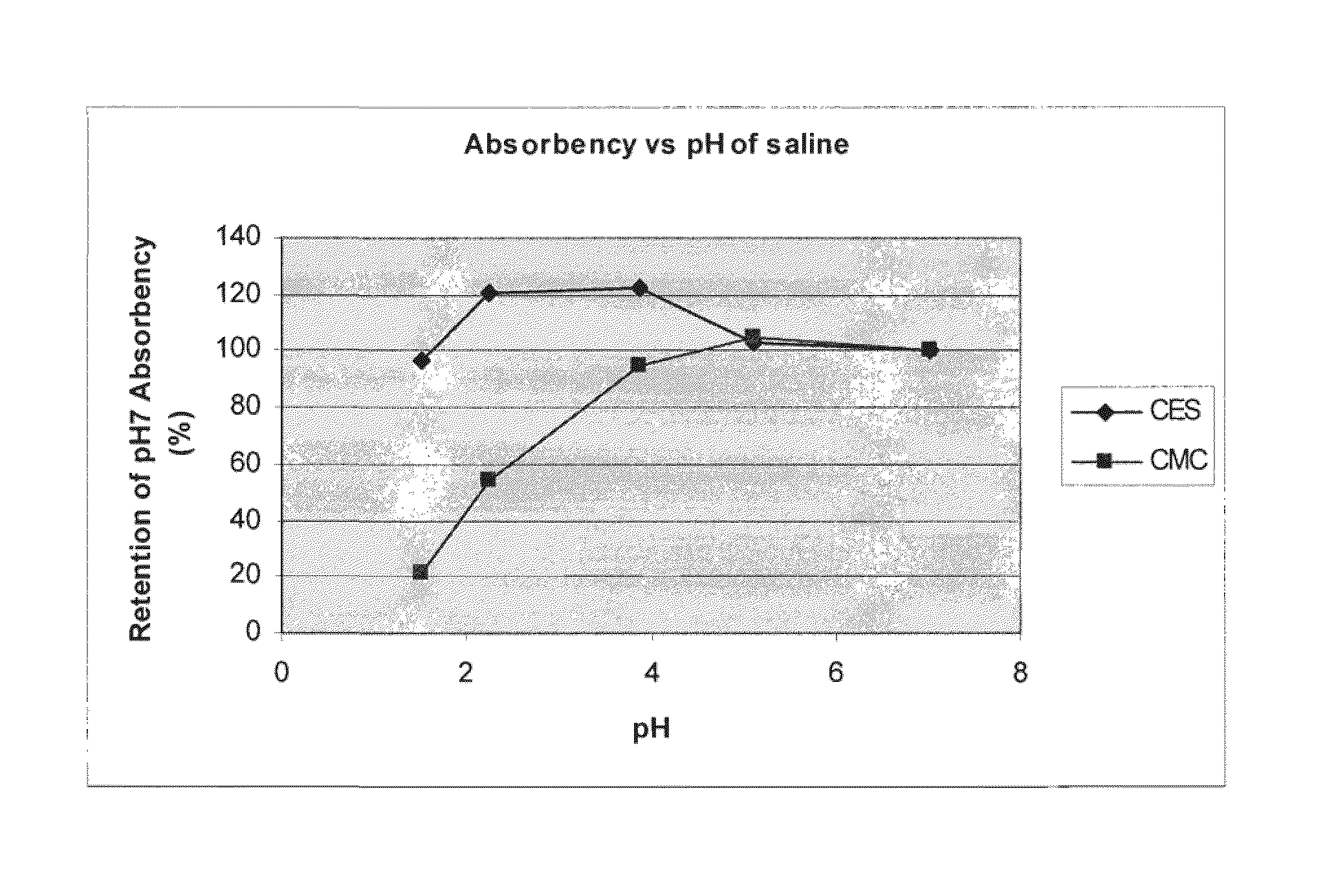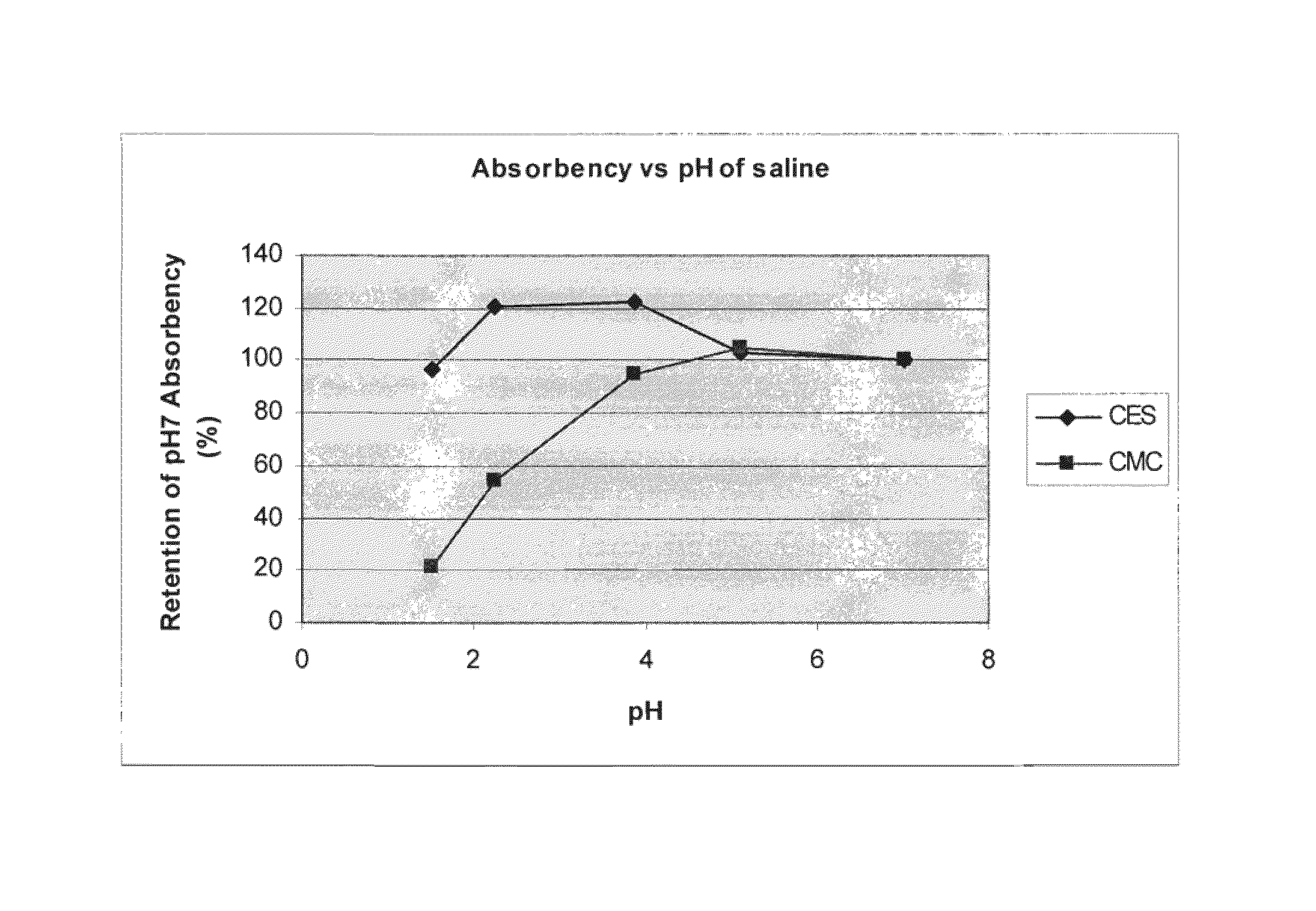Absorbent material
a technology of absorbent materials and absorbent articles, which is applied in the field of absorbent articles, can solve the problems of slow absorption, inability to inability to routinely remove a saturated dressing in one piece, so as to reduce the weight amount of fibers, improve the absorbent effect, and reduce linear density
- Summary
- Abstract
- Description
- Claims
- Application Information
AI Technical Summary
Benefits of technology
Problems solved by technology
Method used
Image
Examples
example 1
Method for Determination of the Free Absorbency of Fibers
[0079]The fiber was cut into a 2-3 mm flock, and 0.5 g of cut fiber was placed in a 100 ml screw-top jar. 50 ml of test liquid (e.g., 0.9% saline, typically used to simulate the ionic strength of wound fluid) was added, and the jar shaken for 30 seconds to disperse the flock. The dispersion was then filtered through a 47 mm Buchner funnel fitted with a 42.5 mm diameter Whatman No. 4 filter paper, using a vacuum pump, with vacuum set to be greater than 0.8 bar for one minute. Then the fiber dispersion was removed and weighed. Fiber free absorbency was calculated using the following formula:
[0080]absorbency(g / g)=[wet_dispersion_weight(g)dry_flock_weight(g)]-1
example 2
Method for Determination of Breaking Tenacity and Elongation of Single Filaments
[0081]Tenacity and elongation at break of dry, single filaments was carried out using a tensile testing machine, fitted with appropriate jaws for gripping single filaments and load cell of the appropriate range.
[0082]The samples were conditioned for at least four hours and were tested in the standard atmosphere for testing textiles (20±2° C. and 65±2% relative humidity).
[0083]The machine was balanced and calibrated according to the manufacturer's instructions. Filaments were taken at random from different parts of the sample. The linear density of the filament was measured by an appropriate technique such the Vibraskop method. The filament was then placed between the jaws of the tensile testing machine and the test started. The following conditions were used:
[0084]
Test length:20mmLoad range:0-10cNCross-head speed:10mm / minuteChart speed (when applicable):10-20mm / minuteNumber of tests:10
[0085]After rupture...
example 3
Preparation of Cellulose Ethyl Sulfonate Using a Two-Step Process
[0087]A 3 g sample of lyocell tow, known under the tradename TENCEL® (manufactured by Lenzing), was immersed in aqueous 47% sodium hydroxide for 25 minutes at 25° C. Excess sodium hydroxide was then removed by squeezing. Then 25 ml 30% sodium vinyl sulfonate solution (Fluka Chemicals) was added to the fiber and heated at 91° C. for 90 minutes. After this time the reaction mixture was neutralized to pH 7 by adding glacial acetic acid dropwise. Then the excess liquid was squeezed from the fiber, and the fiber was washed twice in a mixture of industrial methylated spirit (“IMS”) and water (80:20 v / v). After drying to constant weight at 60° C., the fiber was tested for absorbency.
[0088]Using the method outlined in Example 1, and an aqueous solution of 0.9% NaCl as the test liquid, an fiber free absorbency value of 11.1 g / g was achieved.
PUM
| Property | Measurement | Unit |
|---|---|---|
| pH | aaaaa | aaaaa |
| pH | aaaaa | aaaaa |
| temperature | aaaaa | aaaaa |
Abstract
Description
Claims
Application Information
 Login to View More
Login to View More - R&D
- Intellectual Property
- Life Sciences
- Materials
- Tech Scout
- Unparalleled Data Quality
- Higher Quality Content
- 60% Fewer Hallucinations
Browse by: Latest US Patents, China's latest patents, Technical Efficacy Thesaurus, Application Domain, Technology Topic, Popular Technical Reports.
© 2025 PatSnap. All rights reserved.Legal|Privacy policy|Modern Slavery Act Transparency Statement|Sitemap|About US| Contact US: help@patsnap.com



